Africa Wild Insect Book: Hopperbugs: Cicadas, spittlebugs, leafhoppers, treehoppers, and planthoppers (Order Hemiptera, Auchenorrhyncha)
Hemiptera is an order of insects most often known as the true bugs (cf. bug), comprising cicadas, aphids, planthoppers, leafhoppers, shield bugs, and others.
Bugs have sucking mouthparts whereas groups that can have a similar appearance, such as the beetles, have biting mouthparts. Most bugs are plant suckers making them important agricultural and garden pests, although there are a number of groups, such as the assassin bugs (Reduviidae), that are predatory.
Planthoppers can be separated from members of the Cicadomorpha by the location of the antennae which are ventral to the compound eyes (except in one cixiid subfamily in which the compound eyes are positioned anteroventrally to the compound eyes but are partially surrounded by cup-like concavities); the enlarged antennal pedicel bearing wart-like sensilla; the presence, in most taxa, of pad-like tegulae at the base of the forewings; the presence, again, in most taxa, of a “Y-vein”, that is, two anal veins coalescing on the clavus of the forewing to form a “Y-shaped” set of veins; the elongate, widely separated base of the mesothoracic coxae; and the lack of rows of setae along the shaft of each metathoracic tibia.
Upload your picture of a hopperbug and add a description underneath. Please only do one species per post.
All entries will be edited and updated (additional photos and information will be added by moderators). New entries will be posted according to taxonomic order and the post date does not reflect the actual date of new posts.
AW Insect Book: Hopperbugs Hemiptera, Auchenorrhyncha
Moderator: Klipspringer
Index to Hopperbugs (Order Hemiptera, Auchenorrhyncha)
Index to Hopperbugs (Order Hemiptera, Auchenorrhyncha)
Infraorder Cicadomorpha (Spittlebugs, Cicadas, Leafhoppers and Treehoppers )
Superfamily: Cicadoidea (Cicadas)
Family: Cicadidae (Typical Cicadas)
Brevisiana brevis Shrill Thorntree Cicada viewtopic.php?p=233084#p233084
Oxypleura quadraticollis Axe-head Cicada viewtopic.php?p=233085#p233085
Platypleura sp. Orangewing Cicada viewtopic.php?p=233086#p233086
Severiana severini Broadwing Cicada viewtopic.php?p=233088#p233088
Superfamily: Cercopoidea (Spittlebugs)
Family: Cercopidae (Froghoppers)
Locris areata Red Spittle Bug viewtopic.php?p=233089#p233089
Superfamily: Membracoidea (Leafhoppers & Treejoppers)
Family Cicadellidae (Typical Leafhoppers)
Subfamily Deltocephalinae
Circulifer cf obtusiceps = Neoaliturus obtusiceps Kalahari Leafhopper viewtopic.php?p=501853#p501853
Leafhopper viewtopic.php?p=233091#p233091
Infraorder Fulgoromorpha
Superfamily: Fulgoroidea (Planthoppers)
Family Cixiidae (Cixiid Planthoppers)
Planthopper viewtopic.php?p=533975#p533975
Family: Eurybrachidae (Squathoppers)
Paropioxys jucundus Moth Bug, Mottled Avocado Bug viewtopic.php?p=233093#p233093
Family: Flatidae (Flatid Planthoppers)
Flatine Planthopper viewtopic.php?f=247&t=3195&start=10#p248903
Family: Dictyopharidae (Dictyopharid Planthoppers)
Dictyophara sp. Dictyopharid Planthopper viewtopic.php?p=233095#p233095
Dictyopharine Planthopper viewtopic.php?p=502587#p502587
Family: Fulgoridae (Fulgorid Planthoppers)
Capocles podlipaevi Snout Bug viewtopic.php?p=502485#p502485
Zanna sp. Twig Snout Bug viewtopic.php?p=327059#p327059
Family: Meenoplidae (Small Planthoppers)
Anigrus cf sordidus Small Planthopper viewtopic.php?p=533603#p533603
Family: Tettigometridae
Hilda patruelis Plant Hopper, Groundnut Hopper viewtopic.php?p=233097#p233097
Infraorder Cicadomorpha (Spittlebugs, Cicadas, Leafhoppers and Treehoppers )
Superfamily: Cicadoidea (Cicadas)
Family: Cicadidae (Typical Cicadas)
Brevisiana brevis Shrill Thorntree Cicada viewtopic.php?p=233084#p233084
Oxypleura quadraticollis Axe-head Cicada viewtopic.php?p=233085#p233085
Platypleura sp. Orangewing Cicada viewtopic.php?p=233086#p233086
Severiana severini Broadwing Cicada viewtopic.php?p=233088#p233088
Superfamily: Cercopoidea (Spittlebugs)
Family: Cercopidae (Froghoppers)
Locris areata Red Spittle Bug viewtopic.php?p=233089#p233089
Superfamily: Membracoidea (Leafhoppers & Treejoppers)
Family Cicadellidae (Typical Leafhoppers)
Subfamily Deltocephalinae
Circulifer cf obtusiceps = Neoaliturus obtusiceps Kalahari Leafhopper viewtopic.php?p=501853#p501853
Leafhopper viewtopic.php?p=233091#p233091
Infraorder Fulgoromorpha
Superfamily: Fulgoroidea (Planthoppers)
Family Cixiidae (Cixiid Planthoppers)
Planthopper viewtopic.php?p=533975#p533975
Family: Eurybrachidae (Squathoppers)
Paropioxys jucundus Moth Bug, Mottled Avocado Bug viewtopic.php?p=233093#p233093
Family: Flatidae (Flatid Planthoppers)
Flatine Planthopper viewtopic.php?f=247&t=3195&start=10#p248903
Family: Dictyopharidae (Dictyopharid Planthoppers)
Dictyophara sp. Dictyopharid Planthopper viewtopic.php?p=233095#p233095
Dictyopharine Planthopper viewtopic.php?p=502587#p502587
Family: Fulgoridae (Fulgorid Planthoppers)
Capocles podlipaevi Snout Bug viewtopic.php?p=502485#p502485
Zanna sp. Twig Snout Bug viewtopic.php?p=327059#p327059
Family: Meenoplidae (Small Planthoppers)
Anigrus cf sordidus Small Planthopper viewtopic.php?p=533603#p533603
Family: Tettigometridae
Hilda patruelis Plant Hopper, Groundnut Hopper viewtopic.php?p=233097#p233097
AW Insect Book: Hemiptera, Auchenorrhyncha, Cicadidae
Family Cicadidae (Cicadas, Christmas Beetles)
Large well-known family whose shrill buzzing is a characteristic summer sound. Males have a pair of circular sound-producing organs (tymbals) that appear as two round membranes on either side of the abdomen, each reinforced with a strong circular ring. A muscle attached to the centre contracts, and the recoil produces a click; rapid contraction of these muscles produces a shrill continuous noise. Both sexes have ears (larger in males) on the underside of the abdomen. Males have at least one specific call to which females are attracted. One calling male stimulates others to join in, forming a chorus. Cicadas have two pairs of transparent wings, often attractively marked in dull colours. Exotic species lay eggs in slits made in twigs, and the newly hatched nymphs dig into the ground using their very enlarged fore legs. Here they feed on roots, and it takes many years (sometimes over a decade) before they emerge, climb up a tree, and moult into adults, leaving the dry nymphal skin attached to the tree bark.
Cicadas have three ocelli between the large compund eyes, in the Oxypleurini these are shiny white. It's these ocelli that detect changes in light and gives the Cicada an advantage over their predators.
About 140 species occur in the region.
Links: Checklist: The Cicadas (Homoptera: Cicadoidea) of South Africa
Large well-known family whose shrill buzzing is a characteristic summer sound. Males have a pair of circular sound-producing organs (tymbals) that appear as two round membranes on either side of the abdomen, each reinforced with a strong circular ring. A muscle attached to the centre contracts, and the recoil produces a click; rapid contraction of these muscles produces a shrill continuous noise. Both sexes have ears (larger in males) on the underside of the abdomen. Males have at least one specific call to which females are attracted. One calling male stimulates others to join in, forming a chorus. Cicadas have two pairs of transparent wings, often attractively marked in dull colours. Exotic species lay eggs in slits made in twigs, and the newly hatched nymphs dig into the ground using their very enlarged fore legs. Here they feed on roots, and it takes many years (sometimes over a decade) before they emerge, climb up a tree, and moult into adults, leaving the dry nymphal skin attached to the tree bark.
Cicadas have three ocelli between the large compund eyes, in the Oxypleurini these are shiny white. It's these ocelli that detect changes in light and gives the Cicada an advantage over their predators.
About 140 species occur in the region.
Links: Checklist: The Cicadas (Homoptera: Cicadoidea) of South Africa
- Flutterby
- Posts: 44150
- Joined: Sat May 19, 2012 12:28 pm
- Country: South Africa
- Location: Gauteng, South Africa
- Contact:
AW Insect Book: Hemiptera, Auchenorrhyncha, Cicadidae
Shrill Thorntree Cicada Brevisiana brevis
Suborder Auchenorrhyncha. Infraorder Cicadomorpha. Superfamily Cicadoidea. Family Cicadidae. Subfamily Cicadinae. Tribe Platypleurini
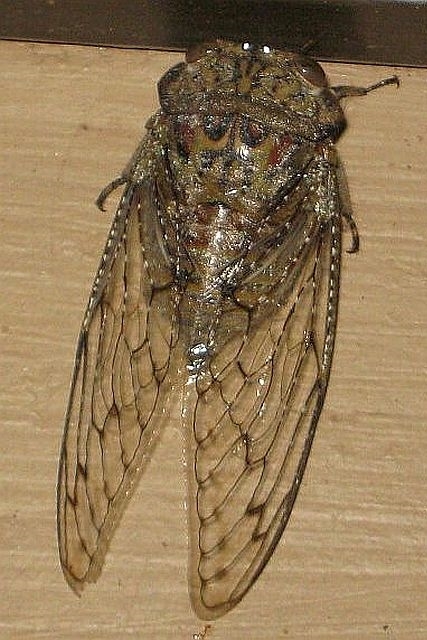
Lower Sabie, Kruger National Park
Another identification from Prof. Villet

 Thank you
Thank you 

Species of Brevisana have a short broad crown without definite margin, rounded to front; the ocelli (photoreceptor "eyes") are small, close to anterior margin; there are striae transverse. Tibia of the hind legs with outer row of "hairs" (setae) consisting only of large setae. Forewings translucent with raised, rugose veins, especially on the basal portion of the forewing (corium), and a small appendix.
Brevisana brevis:
The sexes are dimorphic, the males possessing a white band across the base of the abdomen which is lacking in the female. Wings are patterned (forewing veins usually with white spots). Paranotal lobes rounded; medium-sized species (forewing length 27-31 mm).
Brevisana brevis is the loudest insect on record. It has been recorded producing a calling song with a mean sound pressure level of 106 decibels at a distance of 50 cm.
Distribution
South Africa (KwaZulu-Natal, Mpumalanga and Nothern Province), Botswana, Zimbabwe, Malawi; from October to April.
Links:
https://www.researchgate.net/publicatio ... b/download
Suborder Auchenorrhyncha. Infraorder Cicadomorpha. Superfamily Cicadoidea. Family Cicadidae. Subfamily Cicadinae. Tribe Platypleurini

Lower Sabie, Kruger National Park
Another identification from Prof. Villet
Species of Brevisana have a short broad crown without definite margin, rounded to front; the ocelli (photoreceptor "eyes") are small, close to anterior margin; there are striae transverse. Tibia of the hind legs with outer row of "hairs" (setae) consisting only of large setae. Forewings translucent with raised, rugose veins, especially on the basal portion of the forewing (corium), and a small appendix.
Brevisana brevis:
The sexes are dimorphic, the males possessing a white band across the base of the abdomen which is lacking in the female. Wings are patterned (forewing veins usually with white spots). Paranotal lobes rounded; medium-sized species (forewing length 27-31 mm).
Brevisana brevis is the loudest insect on record. It has been recorded producing a calling song with a mean sound pressure level of 106 decibels at a distance of 50 cm.
Distribution
South Africa (KwaZulu-Natal, Mpumalanga and Nothern Province), Botswana, Zimbabwe, Malawi; from October to April.
Links:
https://www.researchgate.net/publicatio ... b/download
AW Insect Book: Hemiptera, Auchenorrhyncha, Cicadidae
Savanna Sharpcollar Cicada, Axe-head Cicada Oxypleura quadraticollis
Suborder Auchenorrhyncha. Infraorder Cicadomorpha. Superfamily Cicadoidea. Family Cicadidae. Subfamily Cicadinae. Tribe Platypleurini

Shimuwini, Kruger National Park © Alf
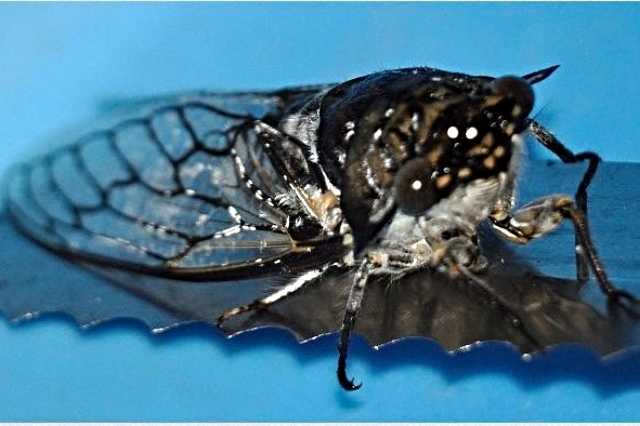 © BluTuna
© BluTuna
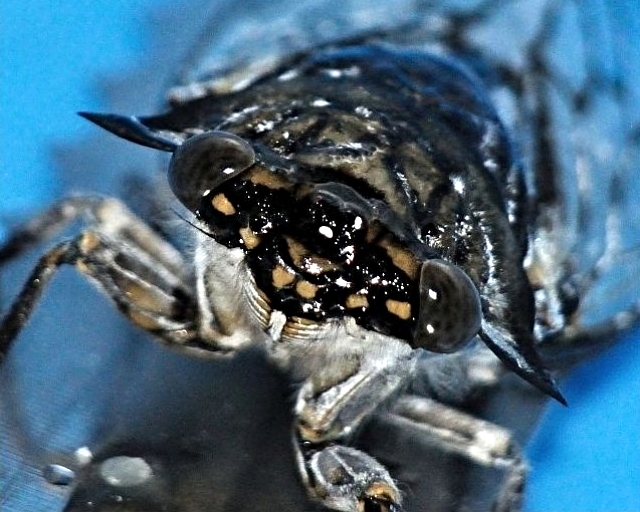 © BluTuna
© BluTuna
Kruger National Park
The genus Oxypleura is distinguished by the lateral development of the prothorax.
Distribution
South Africa (Mpumalanga & Northern Province), Botswana, Zimbabwe; from November to February.
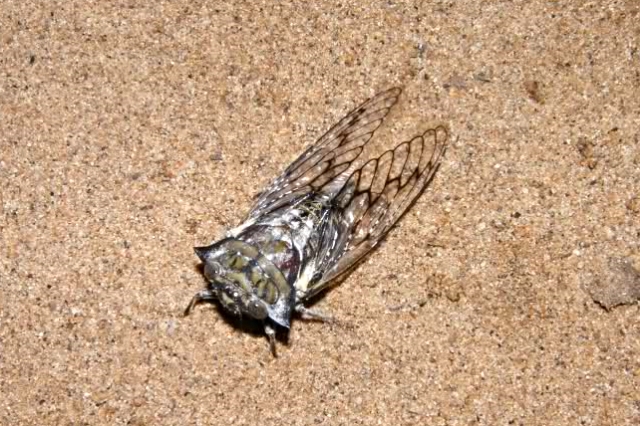 © serval
© serval
Kruger National Park
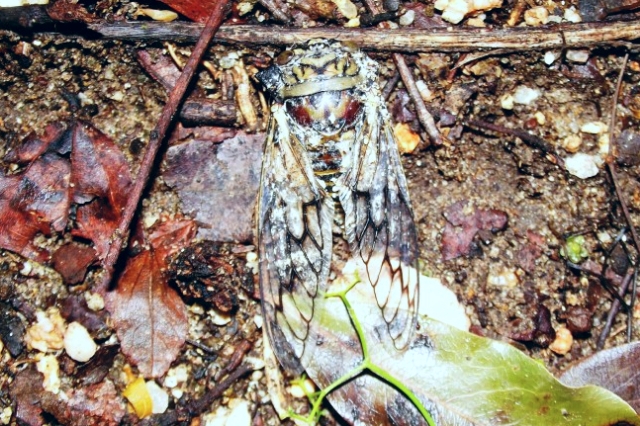 © mposthumus
© mposthumus
Kruger National Park, Tamboti
Towards the end of their relatively brief adult lives cicadas become moribund and often partly covered in fungus before they die. Like this one. Their reproductive functions fulfilled, they shut down and perish.
Links:
Checklist: The Cicadas (Homoptera: Cicadoidea) of South Africa
Suborder Auchenorrhyncha. Infraorder Cicadomorpha. Superfamily Cicadoidea. Family Cicadidae. Subfamily Cicadinae. Tribe Platypleurini

Shimuwini, Kruger National Park © Alf
 © BluTuna
© BluTuna © BluTuna
© BluTunaKruger National Park
The genus Oxypleura is distinguished by the lateral development of the prothorax.
Distribution
South Africa (Mpumalanga & Northern Province), Botswana, Zimbabwe; from November to February.
 © serval
© servalKruger National Park
 © mposthumus
© mposthumusKruger National Park, Tamboti
Towards the end of their relatively brief adult lives cicadas become moribund and often partly covered in fungus before they die. Like this one. Their reproductive functions fulfilled, they shut down and perish.
Links:
Checklist: The Cicadas (Homoptera: Cicadoidea) of South Africa
Hunting cannot be considered a sport as all contestants in a sport should know they are playing the game!
- nan
- Posts: 26307
- Joined: Thu May 31, 2012 9:41 pm
- Country: Switzerland
- Location: Central Europe
- Contact:
AW Insect Book: Hemiptera, Auchenorrhyncha, Cicadidae
Orangewing Cicada Platypleura sp. not yet named
Suborder: Auchenorrhyncha. Infraorder: Cicadomorpha. Superfamily: Cicadoidea. Family: Cicadidae. Subfamily: Cicadinae. Tribe: Platypleurini
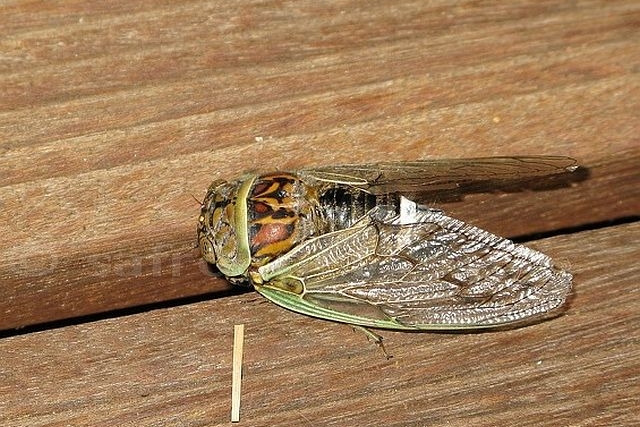
Kgalagadi Transfrontier Park
I contacted a cicada specialist yesterday to get help with the identification and Prof Martin H. Villet, Department of Zoology & Entomology, Rhodes University, Grahamstown, was kind enough to provide us with the identification:

 Thank you for your assistance, much appreciated
Thank you for your assistance, much appreciated 
The cicada genus Platypleura occurs widely across Africa and southern Asia. Some of the South African species are remarkable for their endothermic thermoregulation that enables crepuscular signalling, an adaptation that reduces risk of predation and enables a greater range for their calls. In field experiments their maximum body temperature while calling at dusk, was measured at 22°C above ambient temperature.
The Platypleurini are distributed from the Cape in South Africa, throughout sub-Saharan Africa and Madagascar, through India and south East Asia, to Japan. Those of southern and east Africa resemble the Asian group. Endothermy occurs in several large-bodied South American and South African species, but not in related small-bodied species.
Links: Wikipedia
Suborder: Auchenorrhyncha. Infraorder: Cicadomorpha. Superfamily: Cicadoidea. Family: Cicadidae. Subfamily: Cicadinae. Tribe: Platypleurini

Kgalagadi Transfrontier Park
I contacted a cicada specialist yesterday to get help with the identification and Prof Martin H. Villet, Department of Zoology & Entomology, Rhodes University, Grahamstown, was kind enough to provide us with the identification:
It is indeed a new species of Platypleura that i am busy naming at the moment. A nice find!
The cicada genus Platypleura occurs widely across Africa and southern Asia. Some of the South African species are remarkable for their endothermic thermoregulation that enables crepuscular signalling, an adaptation that reduces risk of predation and enables a greater range for their calls. In field experiments their maximum body temperature while calling at dusk, was measured at 22°C above ambient temperature.
The Platypleurini are distributed from the Cape in South Africa, throughout sub-Saharan Africa and Madagascar, through India and south East Asia, to Japan. Those of southern and east Africa resemble the Asian group. Endothermy occurs in several large-bodied South American and South African species, but not in related small-bodied species.
Links: Wikipedia
Kgalagadi lover… for ever
https://safrounet.piwigo.com/
https://safrounet.piwigo.com/
AW Insect Book: Hemiptera, Auchenorrhyncha, Cicadidae
Broadwing Cicada Severiana severini
Suborder: Auchenorrhyncha. Infraorder: Cicadomorpha. Superfamily: Cicadoidea. Family: Cicadidae. Subfamily: Cicadinae. Tribe: Platypleurini
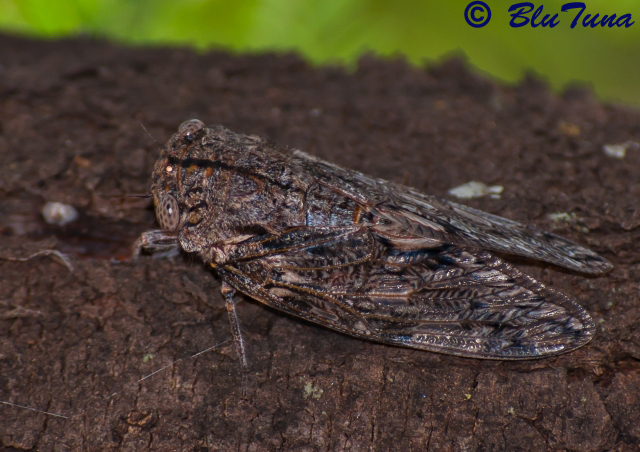 © BluTuna
© BluTuna
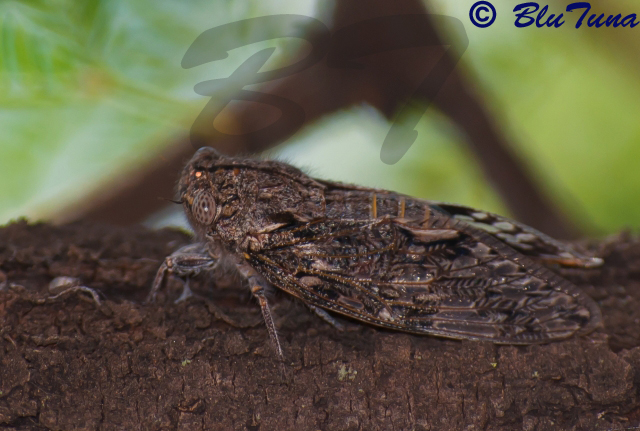 © BluTuna
© BluTuna
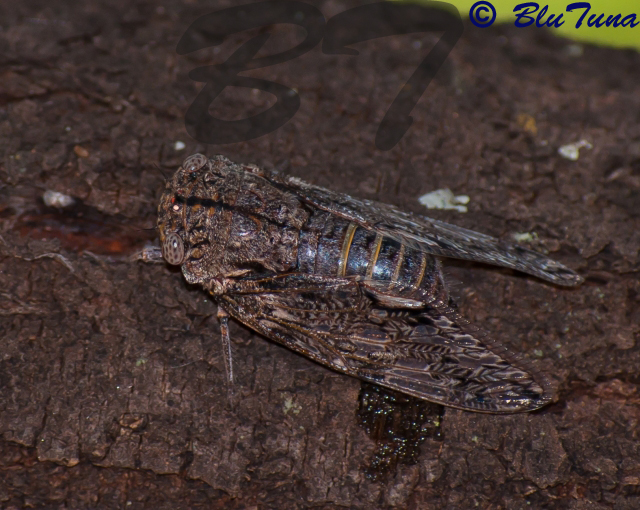 © BluTuna
© BluTuna
Pilanesberg
Description
Width of head about equal to that of mesonotum. Pronotum with the lateral margins lobately expanded, more or less angular. Fore wings not hyaline but opaque.
Distribution
Mpumalanga and Northern Province, north to Zimbabwe, Botswana, and Namibia; September to January.
Links: Photo
Suborder: Auchenorrhyncha. Infraorder: Cicadomorpha. Superfamily: Cicadoidea. Family: Cicadidae. Subfamily: Cicadinae. Tribe: Platypleurini
 © BluTuna
© BluTuna © BluTuna
© BluTuna © BluTuna
© BluTunaPilanesberg
Description
Width of head about equal to that of mesonotum. Pronotum with the lateral margins lobately expanded, more or less angular. Fore wings not hyaline but opaque.
Distribution
Mpumalanga and Northern Province, north to Zimbabwe, Botswana, and Namibia; September to January.
Links: Photo
AW Insect Book: Hemiptera, Auchenorrhyncha, Cercopidae
Family Cercopidae (Spittle Bugs, Froghoppers)
Froghoppers are common in Africa. The nymphs are called spittle bugs, as they secrete and are concealed in spittle-like foam that protects against enemies, parasitoids and desiccation. This foam results from a mix of anal secretions, glandular slime and air. Nymphs have an almost closed concavity on the underside of the abdomen, which serves as a chamber for mixing of the spittle ingredients. Some nymphs live underground on the roots of plants, others on grasses and (the larger species) on shrubs and trees.
Adults are medium-sized and stoutly built, with cone-shaped end of head, and almost round eyes, and often have brightly coloured fore wings. They jump, but do not secrete wax (like planthoppers). Both stages of cercopids are sap feeders and thus affect tree growth to some extent.
There are 33 species known from the region, most belonging to the genus Locris.
Froghoppers are common in Africa. The nymphs are called spittle bugs, as they secrete and are concealed in spittle-like foam that protects against enemies, parasitoids and desiccation. This foam results from a mix of anal secretions, glandular slime and air. Nymphs have an almost closed concavity on the underside of the abdomen, which serves as a chamber for mixing of the spittle ingredients. Some nymphs live underground on the roots of plants, others on grasses and (the larger species) on shrubs and trees.
Adults are medium-sized and stoutly built, with cone-shaped end of head, and almost round eyes, and often have brightly coloured fore wings. They jump, but do not secrete wax (like planthoppers). Both stages of cercopids are sap feeders and thus affect tree growth to some extent.
There are 33 species known from the region, most belonging to the genus Locris.
AW Insect Book: Hemiptera, Auchenorrhyncha, Cercopidae
Red Spittle Bug Locris areata
Suborder: Auchenorrhyncha. Family: Cercopidae
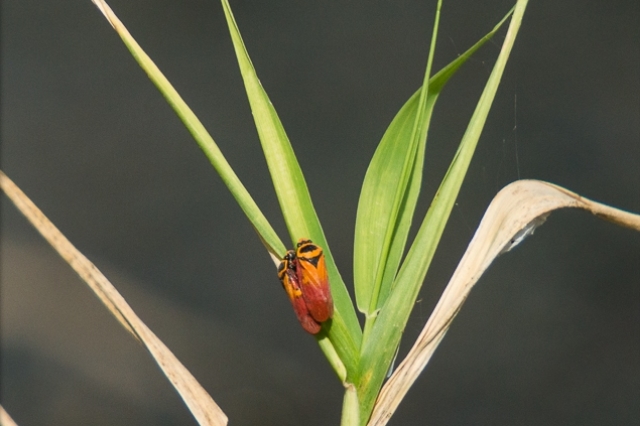 © Kesheshe
© Kesheshe
Kruger National Park
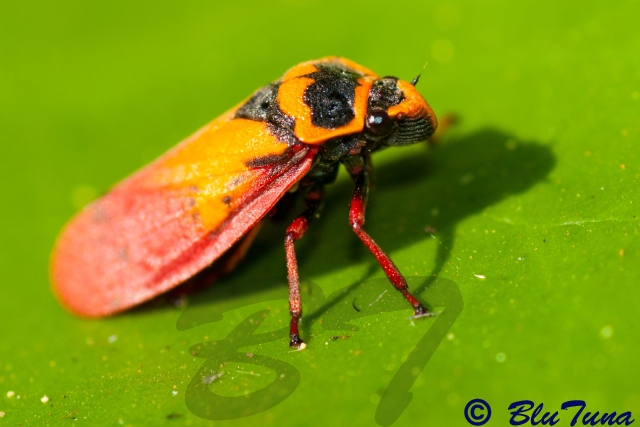 © BluTuna
© BluTuna
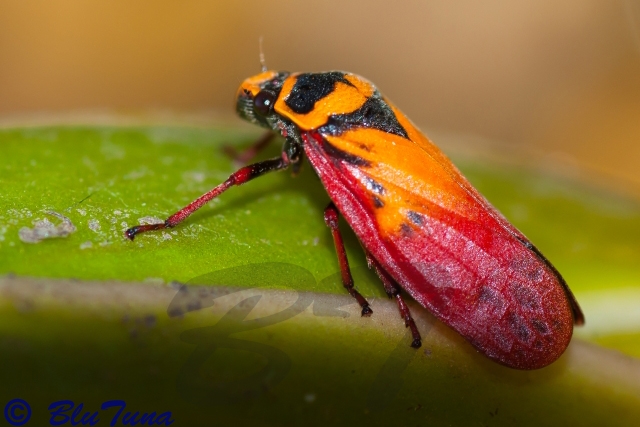 © BluTuna
© BluTuna
Ngwenya Lodge
Suborder: Auchenorrhyncha. Family: Cercopidae
 © Kesheshe
© KeshesheKruger National Park
 © BluTuna
© BluTuna © BluTuna
© BluTunaNgwenya Lodge
AW Insect Book: Hemiptera, Auchenorrhyncha, Cicadellidae
Family Cicadellidae (Leafhoppers)
This is a large family with numerous African species, previously known as Jassidae. Leafhoppers are small, usually less than 20 mm long, delicately slender insects, widest in the front and narrowing towards the abdominal tip. They are either colorful (many bright green) or cryptic. May resemble small slim froghoppers (Cercopidae), but have very enlarged leg bases and at least one row of small spines along thin part of hind tibiae. Excellent jumpers. They sometimes occur in groups, usually on or under foliage. When disturbed, they readily escape by jumping and flying. Many leafhoppers are highly host-specific, feeding on trees, shrubs and grasses. Particularly abundant on grasses, the Western Cape fauna rich and distinctive A characteristic white patch appears where they destroy the leaf chlorophyll after feeding, and where numbers are high this may cause the entire leaf to dra out. Many are pests of economic significance, since they transmit viral (e.g. maize streak virus), fungal and bacterial diseases.
About 350 species are known from the region.
This is a large family with numerous African species, previously known as Jassidae. Leafhoppers are small, usually less than 20 mm long, delicately slender insects, widest in the front and narrowing towards the abdominal tip. They are either colorful (many bright green) or cryptic. May resemble small slim froghoppers (Cercopidae), but have very enlarged leg bases and at least one row of small spines along thin part of hind tibiae. Excellent jumpers. They sometimes occur in groups, usually on or under foliage. When disturbed, they readily escape by jumping and flying. Many leafhoppers are highly host-specific, feeding on trees, shrubs and grasses. Particularly abundant on grasses, the Western Cape fauna rich and distinctive A characteristic white patch appears where they destroy the leaf chlorophyll after feeding, and where numbers are high this may cause the entire leaf to dra out. Many are pests of economic significance, since they transmit viral (e.g. maize streak virus), fungal and bacterial diseases.
About 350 species are known from the region.


